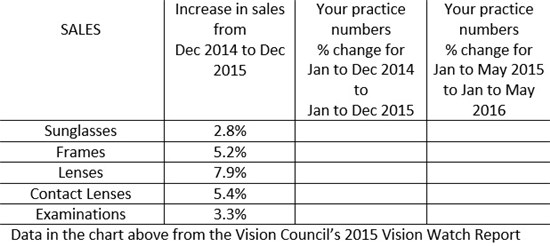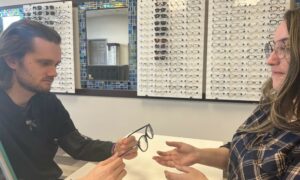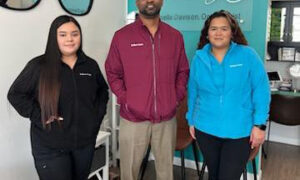
June 8, 2016
The spectacle lenses and lens treatments sector of practices are showing strength, findings from Jobson Optical Research’s 2016 Premium Lenses MarketPulse suggest. Compared to three years ago, 65 percent of retailers said that spectacle lenses and treatments made up a larger percentage of their location’s total gross dollar sales in 2015. In 2015, 53 percent said pricing on spectacle lenses and treatments has increased compared to three years ago as well, and 46 percent said that Rx sun lenses as a percentage of total dollar sales increased over the same period.
So, three positive trends occurred last year. Let’s explore these trends.
LENS SALES ARE UP. Sixty-five percent of retailers said that spectacle lenses and treatments made up a larger percentage of their location’s total gross dollar sales.
According to the Vision Council’s 2015 VisionWatch Report, in December 2013, there were 182,800,000 American adults wearing any form of vision correction versus 188,700,000 people as of December 2015. That’s an increase of almost 6 million people. In the U.S. there is one birth every eight seconds, one death every 13 seconds, and one international migrant every 28 seconds, resulting in a net gain of one person every 12 seconds.
More people means more potential patients. But are those patients coming in our practices? Are you seeing more patients this year than last year? Run a report on your practice management software comparing the number of patients seen last year during the same time frame to this year during the same time frame.
Now run one more report. How many glasses did you dispense last year compared to this year?
How is your practice doing? Are you seeing more patients this year than you saw last year? Are you dispensing more glasses this year than last year?
RETAIL LENS PRICES ARE RISING. Fifty-three percent said pricing on spectacle lenses and treatments increased compared to three years ago.
Historical inflation rates in the U.S. are: 2011 = 3.2%, 2012 = 2.1%, 2013 = 1.5%, 2014 = 1.6%, 2015 = 0.1%, and 2016 = 1.1%. Inflation increases every year. Your retail pricing needs to increase at least every year to keep up with inflation and lab pricing changes to your practice.
How often do you need to increase your prices? At a minimum, once a year. More realistically, every time you get an increase from a lab, you should increase your fees.
RX SUN SALES ARE UP. Forty-six percent said that Rx sun lenses as a percentage of total dollar sales increased.
Let’s take an overall look at how your practice is doing over time in several categories. Fill in the chart below with numbers from your practice to compare your practice.

If your numbers are better than the Vision Council’s reported numbers, then, great job! Now capture your own best practices so this year will be even better. If you did the same or worse than the Vision Council numbers, then take today to identify what changes you need to implement to improve your practice going forward.
References
www.census.gov
www.usinflationcalculator.com

























